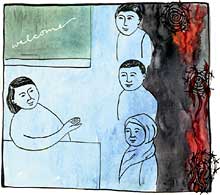Higher Learning: Educators Know Best
When big questions are in play, seek out the experts — teachers.
Your content has been saved!
Go to My Saved Content.
From last May until August, I was in London, where I had a real, grown-up job. A grant from Duke University, where I'm an undergrad, allowed me to work as a temporary researcher and consultant for the Children's Society, a nongovernmental organization (NGO) that works to influence government policy on issues concerning children. My assignment: Study the ways young refugees become assimilated into their new cultures.
My summer position included a brief commute and a nice desk. I took tea breaks and wrote memos that included phrases such as "strategic assessment to better meet target goals set out by the most recent annual report." I loved my job from the beginning, and each day, I worked hard to show that this American college student was mature enough to contribute to a worldwide organization.
As I started researching, I discovered that a wealth of information already existed about young refugees and asylum seekers. In hundreds of policy papers, newspaper articles, case studies, and independent scholarly inquiries, the same needs, desires, fears, and challenges of young immigrant children trying to assimilate their way into their communities and schools appeared again and again: lack of language support, troubles with housing, racism.
Unfortunately, almost none of the studies or articles offered feasible solutions to these perennial problems. Instead, the research indicated that refugee communities are beginning to feel overconsulted. And, once the views of the newcomers are known, policy makers largely ignore their ideas. This puzzled me. There must be solutions. I figured that someone must have an idea.
Because I am nineteen, definitely a nerd, and a longtime lover of school, the answer seemed obvious -- ask teachers.
This was not as obvious as I thought. Almost no literature exists on the teacher perspective for the delicate task of integrating young refugees and asylum seekers into large and crowded public schools. Many NGOs provide services to these schools but have little contact with those who are most frequently in touch with the kids. Teachers work with these youthful immigrants every day, yet their insight on best practices, effective school policies, and social inclusion is rarely solicited.
So, unlike most of the researchers, I did not speak to a single displaced child during the summer. That had already been done. Instead, I focused on the wisdom of people who face the needs of young refugees every day and know how to be as effective as possible using very limited resources. I spoke with a team of three teachers in areas of special educational needs, teachers who worked with hundreds of children at a time in an urban secondary school with almost no outside help. These educators estimated that eighty languages are represented in the school and said that many of the children are in the earliest stages of learning English. I also spoke with a project worker who had helped turn a failing secondary school into a model school for handling refugee intake. Her secret? Work with the organizational framework of the school, rather than simply inserting occasional programming for the students. If the staff are not included, and not committed, she told me, nothing will change.
By the end of my summer project, I had gained an understanding of the relationship between teachers and organizations that I did not find in any of the thousands of pages I had read about young refugees. I learned to question short-term "awareness-raising sessions" and instead look to a whole-school approach for meeting the needs of all students.
I was surprised to see how even those working on behalf of children, often in schools, overlook the valuable knowledge of teachers. Collaboration between organizations and school staff is essential for ensuring lasting changes in the school and effectively using the resources of the organization. When my supervisor asked me for recommendations for a new way of working, I outlined a strategy for meeting young refugee needs that focuses on partnerships between schools and the NGO, emphasizing collaboration between teachers and project workers. I wrote about the comments I heard from teacher after teacher, and almost all of these were new and surprising for my supervisor.
Throughout the project, my supervisor told me that I should not be afraid to state the obvious. So, here it is: Listen to teachers. Seriously. Organizational challenges, lack of funding, puny resources -- these are unfortunate daily facts of life for the public education system. But there are people who have dealt with these pressures for years and have learned some tricks along the way. And they are more than willing to share, I found, if one only asks.
Credit: Sasha Wizansky